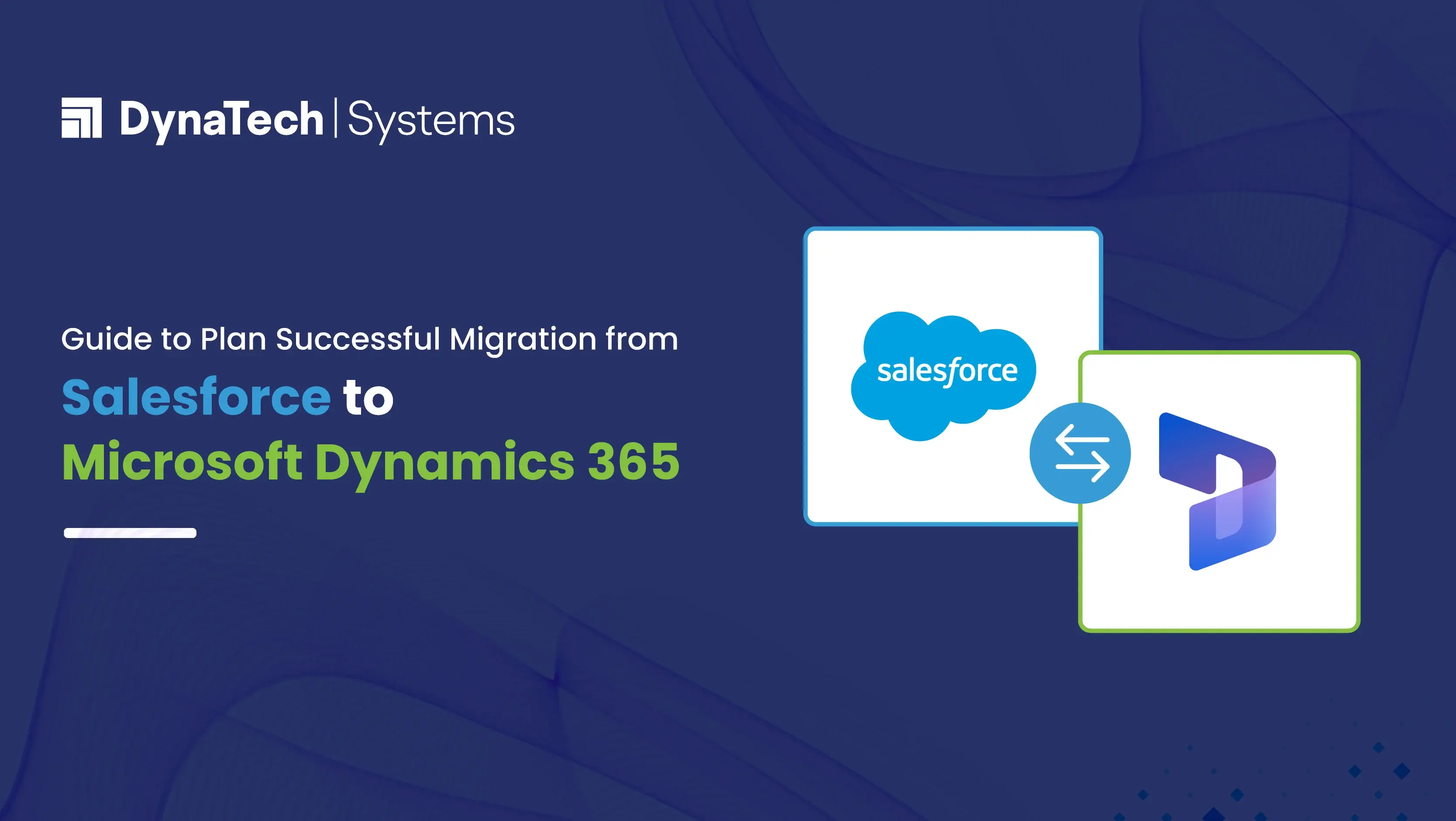Has your business taken the decision to migrate from Salesforce to Microsoft Dynamics 365 but does not know where to start? Is there any dilemma?
Then, this blog is for you. In this article, we will walk you through the process of migration from Salesforce to Microsoft Dynamics 365 and how it will affect your business.
Why do Businesses want Salesforce to Microsoft Dynamics 365 Migration?
Migrating data can be a formidable responsibility due to the significant effort involved in the entire process. It involves gathering data from its original source, handling disparities in format structures between systems, and managing potential errors during data loading. Furthermore, migrating away from Salesforce, which heavily relies on its proprietary code for customization, presents its unique set of hurdles.
Despite all such issues, why do businesses prefer the big switch – from Salesforce to Microsoft Dynamics 365?
Availability of additional functionality that is not offered by Salesforce CRM.
Seamless integration of Microsoft Dynamics 365 with widely used Microsoft products such as Word, Office 365, PowerPoint, Excel, and Outlook.
Microsoft Dynamics 365 is cost-effective compared to Salesforce.
Microsoft offers scalability to companies as per their usage of products and applications with their evolving requirements.
Integration with Microsoft PowerApps and Power BI that empowers organizations with powerful app development and data analytics capabilities.
Unlike Salesforce, which sells add-on functionality at an extra cost, Microsoft Dynamics 365 includes many of these features as part of its existing offering
Factors to Consider Prior to Microsoft Dynamics 365 Data Migration
Since the business has concluded to go ahead with data migration, there are some practices, following which could lead to dodging some common roadblocks.
Planning
The first and foremost step for any migration is Planning. As there are numerous tasks to be
Planning is a crucial step for the initiation of any migration process. With excellent planning, the organization can be assured that each step is executed in the correct order so that the chances of error or dependencies are minimized. Allocate the necessary resources, such as personnel, time, and tools for each task. With a well-structured plan in place, realistic timelines can be established to complete the migration. Setting milestones and deadlines for different stages of the process ensures that the migration process is on track and can be completed in the desired timeframe.
Assessment and Assurance of Data Integrity in Existing System
Prior to the data migration process, it is important to review and clean up the existing data. Your current dataset may appear comprehensive with multiple fields and records, it might be the scenario that it has duplicate entries, inaccuracies, or missing information. Therefore, conducting a thorough data audit and cleansing will ensure data integrity and accuracy thru the migration procedure.
At this stage, identify and document any potential issues concerning data from your source system. Address and mitigate these issues during the salesforce to Microsoft Dynamics 365 migration process to eliminate complications. Familiarize yourself with the new system’s fields and structure to effectively organize and cleanse the data in the source system.
When the data fields are similar in both systems, it is quite a straightforward job. However, complications occur when the new solution proposes fields that were not present in the existing system. If such a case arises, extract data from multiple fields in your current system to populate these new fields. Additionally, if it is vice versa, allocate time to determine whether these fields should be manually added or if alternative options are available to store the data appropriately.
Cleansing and Profiling of Data
As soon as you have understood the depth of data and associated it to the records of the latest platform, you can initiate the procedure of cleaning up data in preparation for the switch. Through data cleansing, you can carefully assess the quality of data, figure out any anomalies, and govern the organization of data for the transition.
If there are repeated instances of empty or improperly maintained data fields, it becomes essential to decide whether the data is crucial or if is there any explicit reason for its absence. One main thing to keep in mind is that though it is obligatory to transfer all data to the new system, minimalizing the volume of data to be migrated will make the process straightforward and quicker.
Key recommendations to consider while cleansing and profiling the data
Make sure that the understanding of storage method and location is distinct while you migrate data from Salesforce to Microsoft Dynamics CRM.
Conduct an unbiased assessment of the present data quality by comparing it with the newly defined policies and standards.
Investigate the primary cause of any data quality issues and assess the probable impact of such issues.
Clearly define your organization’s policies, data standards, and quality requirements. Involve various stakeholders within your organization to ensure comprehensive and inclusive policies.
Carry out steps manually to improve the quality of data and establish systems and processes to avert the occurrence of poor data in the future, based on the recognized root causes.
When you have profiled your data and executed systems to maintain its quality, recurrently monitor and evaluate the performance of these procedures to guarantee they are being successfully carried out
Create a Comprehensive Timeline for Migration
Map out the timeline for your Salesforce to Microsoft Dynamics 365 Migration, ensuring that each and every aspect of your business has a clear vision about their roles and responsibilities within a specific timeline. Proceed with the migration according to the planned schedule once the timeline is in place.
Salesforce to Microsoft Dynamics 365 Migration
Planning
As previously mentioned, planning is the most critical phase that ensures a successful Salesforce to Microsoft Dynamics 365 migration.
Things to keep in mind:
Figure out business procedures that are to be migrated.
Define, involve, and interact with the key stakeholders.
State the target date for the completion of the migration. Do not wait until the last moment to make modifications. Provide at least three to four months to the team to collect data, have meetings, and regulate the CRM operations.
Select the deployment option. Comprehend the ideal deployment that will accomplish the goals and requirements of the organizations. Businesses can opt to migrate to Microsoft Dynamics 365 online, on-premises, or in a private cloud.
Manifest the type of migration
While you manifest the migration from Salesforce to Microsoft Dynamics CRM, it becomes essential to take some decisions regarding the extent and speed of the desired change. The consequences of these decisions help in determining whether a complete implementation is required, or re-platforming is more feasible.
If there is a need for complete implementation, it will involve a comprehensive data reconciliation process. SMEs that are aiming to boost their business processes and leverage the complete capabilities of Microsoft Dynamics 365, should opt for this method.
On the contrary, re-platforming is a simpler approach that comprises migrating existing data from Salesforce to Microsoft Dynamics 365 without any major alterations or process enhancements. While Salesforce integration with is a plausible option, switching to the new system is more viable.
Put together your data
The accuracy and quality of your data play a pivotal role in the success of the CRM migration. The following steps are to be considered while prioritizing data accuracy during migration.
Cleanse the data:
It is advisable to cleanse and profile your data by examining data for errors, correcting it, ensuring that data adheres to the required naming conventions, identifying incomplete records, and getting rid of duplications.
Group the data:
Classify and label data elements in Salesforce and align them to the corresponding categories in Microsoft Dynamics 365. This grouping process creates a clear blueprint that facilitates the smooth transition of data from the legacy system to the new system.
Moving the information
While you migrate data from Salesforce to Microsoft Dynamics CRM, it involves exporting data from Salesforce and importing it into Dynamics 365.
Export:
Not all data fields from Salesforce can be extracted since Microsoft Dynamics 365 may not support certain entities. Ensure that all the fields you intend to export are marked as “visible” and accurately defined, paying attention to the correct letter casing.
Import:
Microsoft Dynamics 365 has a pre-defined import template that includes any variations in calculated fields as well as custom entity types between two platforms. Plan for the import process at least two weeks in advance of the new CRM launch. Alternatively, you can choose to migrate the data in batches, gradually transferring portions of the data to Microsoft Dynamics 365 over a period of time.
Authorize integrations
One of the key advantages of both Microsoft Dynamics 365 and Salesforce is their ability to integrate with third-party systems. However, one important note is that while some integrations are available in Salesforce, this might not be the same for Microsoft Dynamics 365. While making a shift, cautiously pick the apps that you want to replicate and consider other business options offered by Microsoft, such as Microsoft Dynamics 365 Finance, Power Automate, and Power BI.
Furthermore, while performing Microsoft Dynamics 365 integration with Salesforce, data integration tools such as Scribe could be helpful. It simplifies complex migrations from Salesforce to Microsoft Dynamics 365.
What Next?
DynaTech Systems, a Microsoft Solutions Gold partner, is dedicated to providing comprehensive support for businesses throughout the entire process of migrating from Salesforce to Microsoft Dynamics 365. Our team is well-equipped to assist you with planning, migration, data preparation, and smooth transition. DynaTech Systems is committed to offering personalized services to fulfill your unique business requirements. Collaborate with DynaTech Systems to ensure a smooth and successful Salesforce to Microsoft Dynamics 365 migration.




























